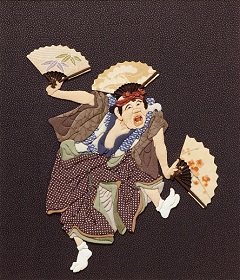About Oshie
japanese traditional patchwork
History
Japanese traditional technique of "Oshie"(Japanese patchwork) is said to be stemming from the technique of stamping picture on "Byobu"(Japanese folding screen) and "Fusuma"(Japanese papered sliding doors) of Heian era(AC700 - 1100). After that, the tradition was handed down little by little and differently in a way that women in the emperor's court used the technique using clothing fragment creating "Byobu" and "Hina" doll(Japanese doll for girls), and "Kaori-box" and etc.
When did the technique get popular among Japan? That's when Tokugawa government system has settled after the war around AC1700 when Japan is in the closure of the country which has boosted the birth of unique Japanese culture. Take the most popular creation "Oshie-Hagoita" which is a Japanese racket with Kabuki-actor, beautiful women, and Sumo example, "Oshie-Hagoita" has still been popular even now as a symbol of new year. Also, in some region, "Hina-doll" and various charms have been created using the technique. Although, in the period of Showa, the tradition started to die out gradually. For now, a little number of creators are passing the technique down.
Material
Silk is the main material. With original picture, creator pick appropriate cloth.
(The color, design, and Kamon may not conform original picture by necessity, beacuse these materials are so hard-to-find.)
How to Create
1. draw design
2. create pattern paper using the design
3. cut cloth as designed
4. paste cut cloth on the design paper using glue and soldering iron.
5. paste all parts as designed
Obsessiveness
In general, eyes, nose, mouth of it are handwritten in the brush. However, Douan Michicko Koshiyama keeps as much as possible the use of the paintbrush, and makes down to the smallest detail, such as facial structure by Oshie technique, so her works became more sense of depth. Please put the cursor on the image.
What's Attractive?
Japanese unique elegance of pattern is the most attractive. With expansion and contraction of cloth, spatial effect is possible.
Most of the themes of Douan / Michiko Koshiyama's creation are Kabuki, Bunraku, Ukiyoe. She reflects the elegance of Japanese traditional beautiful color and cloth usage on her creation, and is willing to let people in the world know the technique as Japanese art.
DOUAN Michiko KOSHIYAMA

